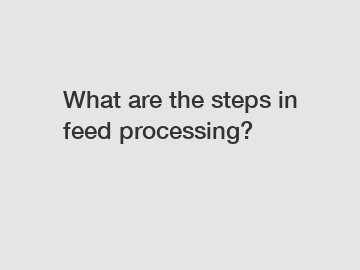What are the steps in feed processing?
What are the steps in feed processing?
Feed processing is a crucial aspect of livestock management that ensures animals receive a nutritionally balanced diet. Implementing the correct steps in feed processing is essential for maintaining the health, growth, and productivity of our livestock. In this article, we will discuss the key steps involved in feed processing and explore their significance in ensuring optimal animal nutrition.
1. Ingredient Selection:

The first step in feed processing is selecting the ingredients. This involves careful consideration of the nutritional requirements and dietary needs of the animals. The selection process should focus on choosing high-quality ingredients that provide essential nutrients such as carbohydrates, proteins, fats, vitamins, and minerals. The ingredients chosen should meet the specific dietary requirements of the target animals, considering factors like age, breed, and production purpose.
2. Grinding or Particle Size Reduction:
Once the ingredients are selected, the next step is to grind or reduce the particle size. Grinding helps improve digestibility, nutrient utilization, and palatability. It also ensures uniform mixing of the ingredients, creating a homogenous mixture. The grinding process can vary depending on the type of feed and the animals' digestive system. Common methods include hammer mills, roller mills, and pulverizers.
3. Mixing:
After grinding, the ingredients are mixed together in the appropriate proportions. Proper mixing ensures uniform distribution of nutrients throughout the feed, preventing nutrient imbalances and optimizing feed quality. Mixing can be done manually or using specialized equipment like horizontal or vertical mixers. The duration and intensity of mixing should also be considered to achieve a consistent and well-mixed feed.
4. Conditioning and Pelleting:
Conditioning is a critical step in feed processing, especially for pelleted feeds. It involves heating the mash feed to a specific temperature and moisture level. Conditioning enhances the feed's nutritional value, improves pellet quality, and increases feed digestibility. This step is particularly important for livestock species with limited stomach capacity, as pelleted feeds are more compact and easier to consume.
5. Pelletizing or Extrusion:
Pelleting or extrusion is the process of forming the conditioned feed into pellet or extruded shapes. Pelleted feeds offer several advantages, including improved feed intake, reduced feed waste, and better nutrient utilization. The process involves compressing the conditioned feed through a die under pressure. The heat and moisture from conditioning aid in binding the ingredients together, resulting in durable pellets or extrudates.
6. Cooling, Screening, and Packaging:
After pelleting or extrusion, the feed must be cooled to room temperature to prevent spoilage. Cooling also improves the feed's durability and reduces the risk of nutrient degradation during storage. Once cooled, the feed undergoes screening to remove fines or oversized particles, ensuring a consistent feed size. Finally, the feed is packaged in suitable containers to maintain its quality and prevent contamination.
In conclusion, feed processing involves several crucial steps to ensure animals receive a nutritionally balanced diet. Ingredient selection, grinding, mixing, conditioning, pelleting or extrusion, cooling, screening, and packaging are essential stages in the feed processing chain. Each step plays a vital role in creating a uniform, palatable, and nutritionally optimized feed for livestock. By following these steps diligently, farmers can enhance animal health, performance, and overall productivity. Adopting proper feed processing techniques is a key responsibility in maintaining the well-being of our livestock.
For more information, please visit coating animal feed, animal feed conditioner, coarse grinding hammer mill.

Comments
0